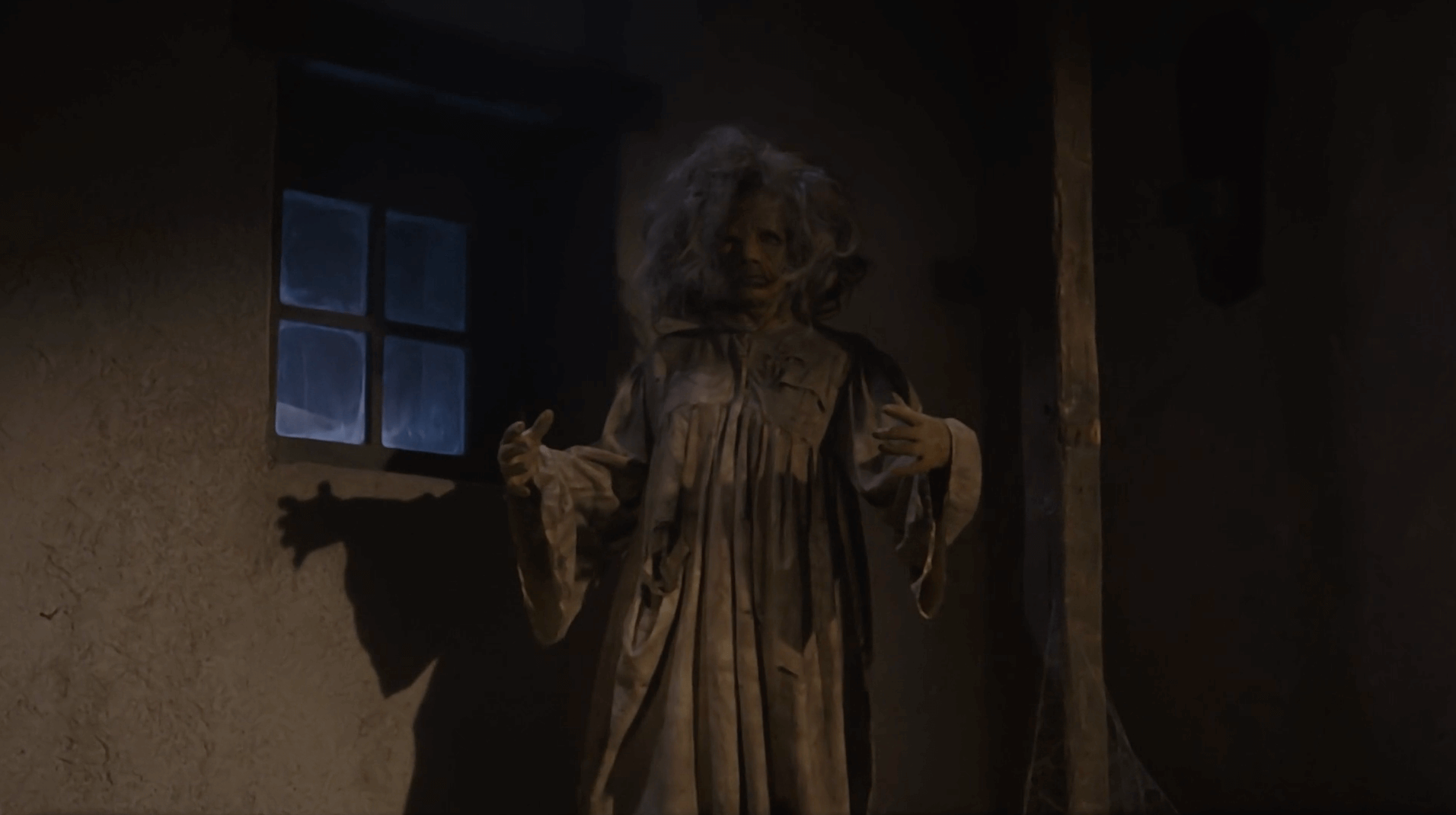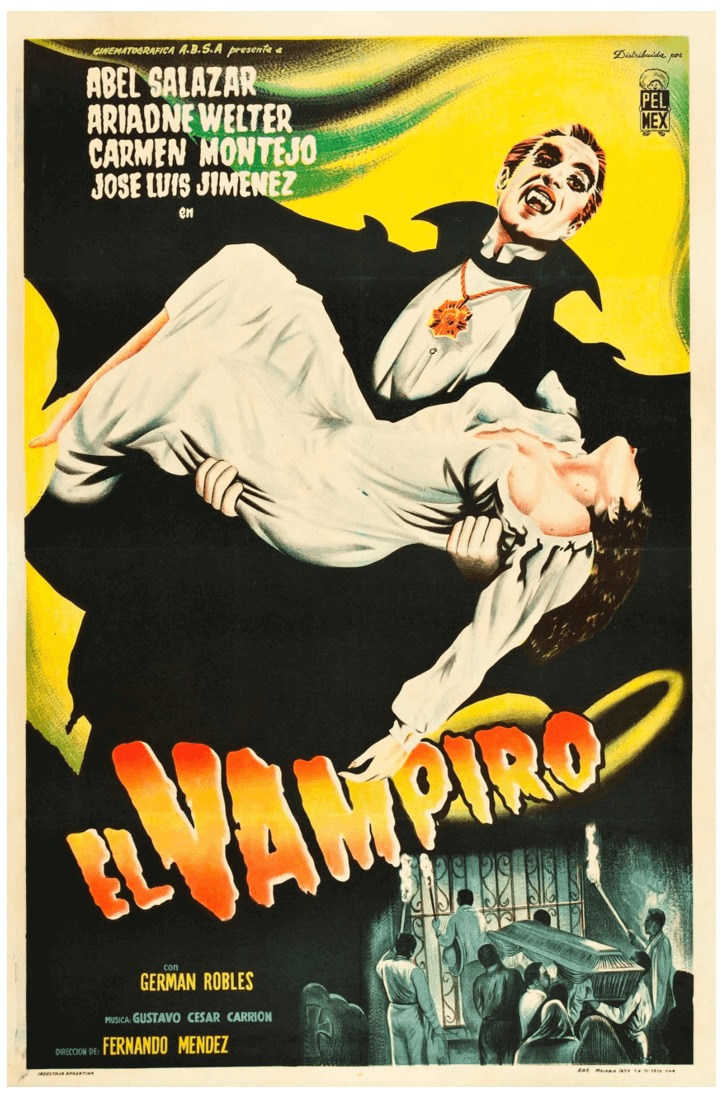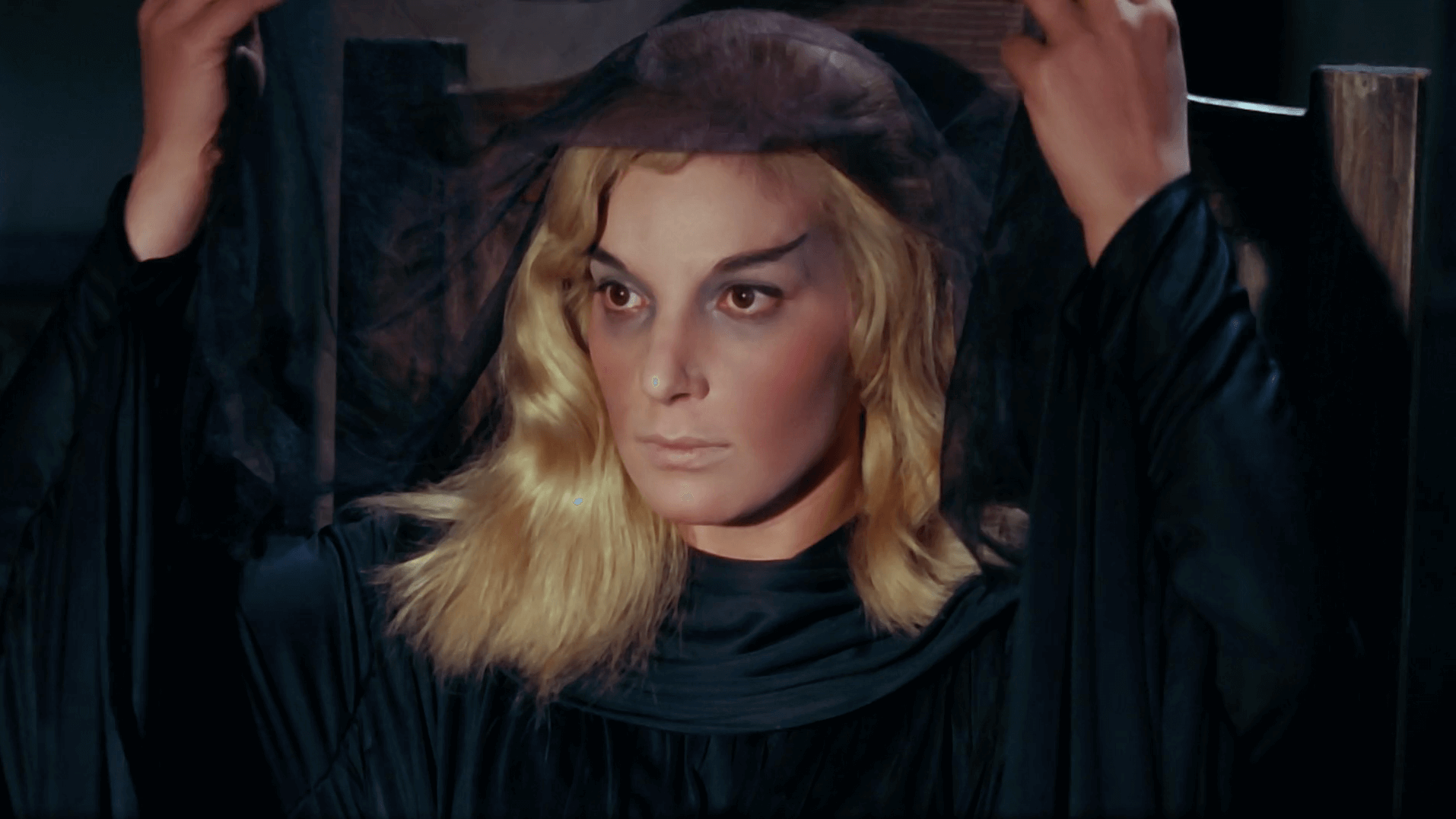Armando Hernández
Noches de oscuros
Mexican Horror Obscurities
of the 1960s–1990s
Warning: some clips on this page contain scenes of graphic violence.

Mexican horror films have been around since the 1930s and were initially about superstitions & ghosts in the regional areas. It all began with with La Llorona (Ramón Peón, 1933), El fantasma del convento (Fernando de Fuentes, 1934), and Dos monjes (Juan Bustillo Oro, 1934).
When the 1950s & 1960s came along, the horror genre went wild. Vampires were especially popular and we have actor Germán Robles to thank for that. He played Count Lavud in El Vampiro (1957), its sequel El Ataúd Del Vampiro (1958), and in the Nostradamus series: La Maldición De Nostradamus (1961), Nostradamus y El Destructor De Los Monstruos (1962), Nostradamus, El Genio De Las Tinieblas (1962) and La Sangre De Nostradamus (1962).
![]()
Other vampires include Guillermo Murray in El Mundo De Los Vampiros (1961) and Aldo Monti in Santo En El Tesoro De Dracula aka “El Vampiro y El Sexo” (1969).
Once the 1970s & 1980s came along, Mexican films of all genres got a little more “serious” with the support of government funding. Some filmmakers followed along by making prestigious films dealing with political realities. But other filmmakers self-funded their own genre movies — mostly action & horror — because they believed these were the movies the public really wanted to see, especially the Mexicans living in the United States.
Today, Mexican horror films of the past are celebrated & praised in Mexico, the United States, and even some other parts of the world. But there are so many that just don’t get the credit they deserve. Maybe some have been released on DVD and Bluray — for instance the expressionist Dos monjes, restored with the support of Martin Scorsese’s World Cinema Project, was added to The Criterion Collection in 2020 — but most have yet to reach a wider audience and are often only seen as “novelties” rather than taken seriously. Some films languish in obscurity waiting to be dug up & found, and I can only hope the titles you’ll read about here will inspire your interest in tracking them down.
When the 1950s & 1960s came along, the horror genre went wild. Vampires were especially popular and we have actor Germán Robles to thank for that. He played Count Lavud in El Vampiro (1957), its sequel El Ataúd Del Vampiro (1958), and in the Nostradamus series: La Maldición De Nostradamus (1961), Nostradamus y El Destructor De Los Monstruos (1962), Nostradamus, El Genio De Las Tinieblas (1962) and La Sangre De Nostradamus (1962).

Other vampires include Guillermo Murray in El Mundo De Los Vampiros (1961) and Aldo Monti in Santo En El Tesoro De Dracula aka “El Vampiro y El Sexo” (1969).
Once the 1970s & 1980s came along, Mexican films of all genres got a little more “serious” with the support of government funding. Some filmmakers followed along by making prestigious films dealing with political realities. But other filmmakers self-funded their own genre movies — mostly action & horror — because they believed these were the movies the public really wanted to see, especially the Mexicans living in the United States.
Today, Mexican horror films of the past are celebrated & praised in Mexico, the United States, and even some other parts of the world. But there are so many that just don’t get the credit they deserve. Maybe some have been released on DVD and Bluray — for instance the expressionist Dos monjes, restored with the support of Martin Scorsese’s World Cinema Project, was added to The Criterion Collection in 2020 — but most have yet to reach a wider audience and are often only seen as “novelties” rather than taken seriously. Some films languish in obscurity waiting to be dug up & found, and I can only hope the titles you’ll read about here will inspire your interest in tracking them down.




El Mundo De Los Vampiros (1961)
The title— The World of the Vampires — says it all. Count Subotai (Guillermo Murray) awakens from his coffin, walks down to the basement of his mansion, which — instead of a typical basement filled with junk — is an other-worldly realm of ghoulish-looking vampires. At night the Count and his servants take women to their lair where they drink their blood in an unusual sacrificial ceremony that includes the Count playing an organ made up of bones. It’s incredible, weird, and so detailed.
Despite its unique and appealing visual style, El Mundo de Los Vampiros remains relatively unknown, but it is one of my favorite vampire films of the early-1960s.


Hasta el viento tiene miedo (1968)
At a boarding school for girls, Claudia and her schoolmates have been forced to stay on campus over the summer as punishment. The girls initially think it’s the worst thing ever, until something much more dreadful happens. As it turns out, the school is being haunted by the spirit of a former student who killed herself there, and the spirit is calling out to Claudia as if to warn her about something….
Carlos Enrique Taboada’s films tend to have evocative titles that relate to his plots, and this one is no exception. Here it translates to “even the wind is afraid,” a line spoken in the film as the wind blows after a tragedy has occurred. Heavy wind in the summer? It’s creepy, very creepy.
This was the movie that earned director Carlos Enrique Taboada the title “Master of Horror” and established his filmmaking style. As in his other films, Hasta el Viento Tiene Miedo features independent female characters, a creepy setting, a supernatural entity haunted by their own tragic background, and an antagonist that is more than just a ghost. To me, this is a great and defining film in Taboada’s career


Santo Y Mantequilla Nápoles En La Venganza De La Llorona (1974)
El Santo has battled every type of monster, but the best is the legendary Mexican ghost, La Llorona.
Here, El Santo is helping a professor to retrieve some sort of treasure that just happens to belong to a mummified woman. When the treasure is taken, the mummy comes to life as La Llorona, who screams for her kids as she seeks to reclaim what was taken from her. El Santo’s friend, the famous Cuban/Mexican boxer Mantequilla Nápoles, joins him in the fight against La Llorona, bringing a bit of goofiness & paranoia to the mix.
El Santo’s movies are fairly popular & well-known, but this particular one deserves a wider audience, since it features a very well-known Mexican superstition. The most legendary Mexican luchador that ever lived goes up against the whaling woman that has scared Mexican people for centuries?? Amazing!
Ultraje ( “Outrage”) is so obscure & forgotten that it almost doesn’t exist. Heck, even the die-hard fans of Troy Donahue don’t even know about it. How sad for this former hunk of the 1950’s and 60’s.
In Ultraje, an aging college professor named Danny marries a young student named Kathy and the two leave the city for a more secluded life in the woods. They have a baby together, and all while everything seems peaceful, their lives are forever ruined by a group of drunken woodworkers who rape Kathy, brutally beat Danny, and set their home on fire. Kathy cannot find her baby and proceeds to commit suicide. Danny is frozen in a state of shock, but remains alive. Several years later, Danny is out for revenge on anyone who enters the woods, since it was such “outsiders” who destroyed his life. He even manages to find the woodworkers, and their demise is brutal as hell.
Ultraje has been described a dramatic psychological thriller, but the scenes with a maddening Danny killing people make this more of a slasher film, with point of view of murders. Keep in mind, this is all before the 80’s slasher boom.
Cazador De Demonios (1983)
Cazador De Demonios (“Demon Hunter”) is an 80’s horror film set in a small regional town in Mexico where something very supernatural is terrorizing local inhabitants — a nagual, a shapeshifting creature from Nahuatl lore.
While we barely ever see the nagual up-close, the plot of this movie is intruiging and unique, and it features some striking kill scenes. I mean after all, when was the last time you watched a movie about a nagual?
Cazador De Demonios was fairly popular when it was first released but has since been forgotten, which is saddening because it’s actually a moody & atmospheric film with a very unique creature in it. This is a film I hope one day will gain some sort of resurgence, be it an homage at a festival or a Blu-ray release from a boutique label.
La Muerte Del Chacal (1984)
Italian giallo films have been favored for as long as they’ve been around, and other countries have tried their hand on emulating this sub-genre. Some have succeeded, others not so much. A few exist in Mexico, but they don’t seem to have gained any attention outside of the country.
La Muerte Del Chacal (“Death of The Jackal”) is a giallo-inspired film with a catchy & creepy musical score that plays from beginning to end. Of course there’s an unseen killer wearing all-black and using a fancy sword as a weapon. There’s also a Doberman that accompanies the killer, symbolizing a gritty mad-dog attitude.
Famous Mexican actors Mario & Fernando Almada, siblings in real life, play two law enforcement brothers investigating a string of murders in the Texas coastal towns of South Padre Island & Port Isabel. The killer targets hookers, strippers, and young hormonal people. Naturally. When the killer is revealed to be one of the brothers, he is locked up in a mental institution from which he manages to escape before setting out to kill his brother and his wife!
This is perhaps the greatest Mexican giallo ever because it really emulated what the Italians and other Euro countries were doing. It has all the markings of a giallo, and to have two of the most famous Mexican action stars, the Almada brothers, is fantastic. Fernando Almada, in particular, is excellent here.
Like Cazador De Demonios, La Muerte Del Chacal was also fairly popular when it was first released and over the years has slipped into obscurity. A Blu-ray really needs to happen.
Noche de fieras (1990)
In the 1990s, Mexican films were in decline. Most were distributed on video rather than having a theatrical release. Noche de fieras is an example of a film that was released theatrically before getting dumped to video.
In Noche de fieras (“Night Of The Beasts”) we meet Ernesto (Hugo Stiglitz) and his gorgeous wife Isabel (Olivia Collins). Their marriage is on very thin ice. They loathe each other. Ernesto lusts after Isabel but resents her inability to get pregnant. They somehow remain married but see other people, who they truly have their hearts set on. Ernesto eventually decides on getting a divorce from Isabel so he can claim a part of an inheritance that her father had left for her and Ernesto. After finding out his mistress is pregnant with his child, Ernesto then decides he must get rid of Isabel so he can claim all of the inheritance rather than only a part of it. He then takes Isabel to her father’s old house in the mountains, which is thought to be haunted. Once they arrive, really weird & creepy stuff starts to happen to Isabel!
I’ll admit that Noche de fieras was a film I didn’t think was going to be interesting, but after my first viewing, I was hooked. While it is a bizarre film, it still has some pretty cool and creepy haunted house scenes involving snakes, mirrors with bodily organs, a shower with green goop, and a pair of ghouls, one of whom resembles a mummy.
Sounds amazing, right? I can only hope Noche de fieras becomes a must-see 90’s haunted house flick.

Obsesion De Matar (1993)
Some countries (Turkey being the main one) have flat-out copied American genre films. Mexico did this too, but they tried to be unique about it. Consider, for example, Ruben Galindo’s Don’t Panic, which emulates Wes Craven’s A Nightmare on Elm Street.
In 1993, Obsesion De Matar (“Obsession To Kill”), a horror-thriller by director Ismael Rodríguez Jr., was released by Mexcinema Video Corp . I first came across it on cable tv many years ago and while watching it, it rang a bell.
On a radio talk show, psychiatrist Dr. Nora (Nora Torrero) discusses matricide with another psychiatrist, giving reasons for how and why it happens. The radio show then receives a phone call from a man named Sebastian (Sebastian Ligarde) using the alias “Pepe” who tells them they’re all wrong about matricide — his reason for killing his own mother was simply out of “love.” In a series of flashbacks, “Pepe” narrates the times he killed women, including his psychotic mother who wanted him all for herself.
Obsesion De Matar feels like the Mexican version of Psycho IV. It follows the same plot, although it is much, much grittier. The movie is very sexual and features incestuous scenes we definitely didn’t see in Psycho IV. Despite being a copycat movie, I still feel Obsesion De Matar is worth a watch. Actor Sebastian Ligarde plays the Norman Bates-like character. If you’re familiar with his work, you know he always plays an antagonist — and here he does a wonderful job.
Armando Hernández is a Mexican genre film enthusiast & writer, specializing in obscure & long-forgotten titles. Based in Pomona, California, he has been writing exclusively on trash-mex.com for 10 years & counting.
